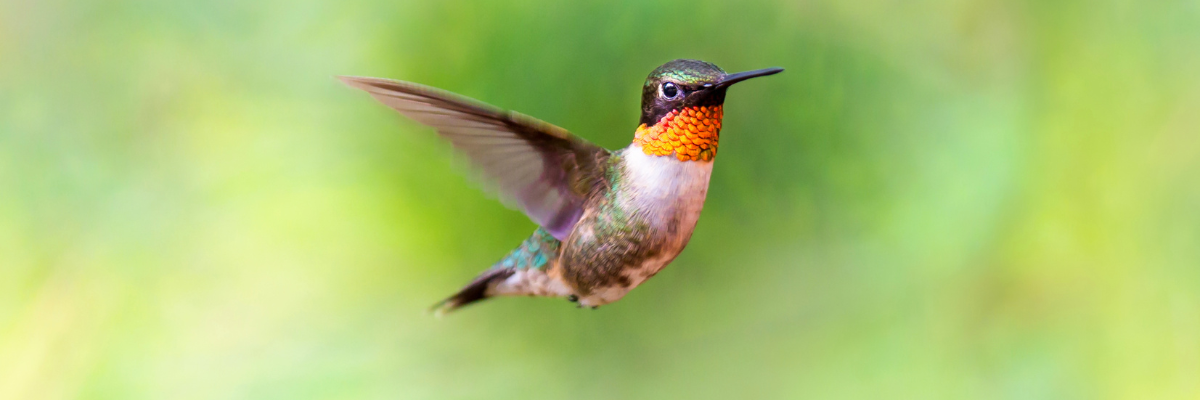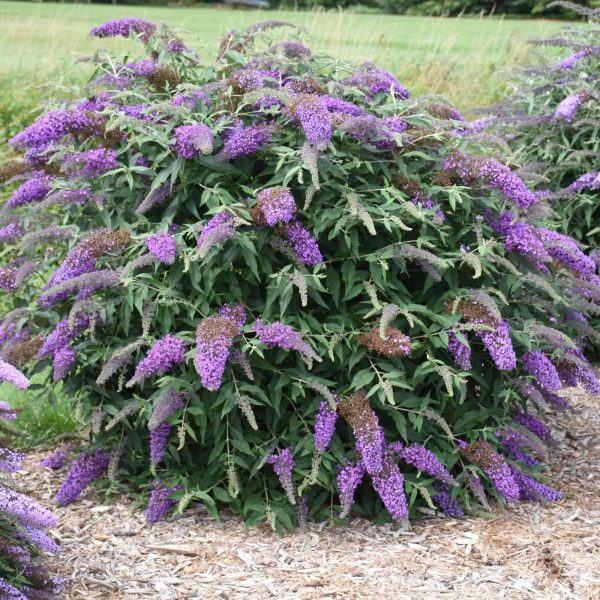Is there anything more entertaining than watching the aerobatic antics of hummingbirds?
Whether they’re visiting for a sip of sugar water at the feeder, zooming through the garden (where you’ll often hear their whirring wings before you see them), or engaging in an aggressive chase with a rival, hummingbirds provide hours of enjoyment. (Who needs Netflix when you can watch your own nature show in the backyard?!)
These tiny birds, though, have voracious appetites: one hummingbird visits an average of 1,000 flowers each day in search of nectar. But they’re also beneficial garden guests, feasting on tiny insects, like gnats and aphids, to satisfy their need for protein. So, while you enjoy their aerial displays, the garden also reaps the rewards of their visits.
To entice hummingbirds to join you in the garden, add their favorite plants, along with a water source, and soon you’ll be ducking these speedy visitors while you work in the garden.

![]()
Because hummingbirds need protein in their diets, avoid using pesticides in your garden. Let these feathered friends take care of tiny pesky pests naturally.
Best plants for hummingbirds
Brightly colored, tubular flowers make the perfect hummingbird buffet. The shape of the bloom and its location is just as important as its color: grow hummingbird-friendly plants where it’s easy for the birds to hover and savor a sip of nectar.
Hummingbirds’ beaks aren’t like a straw: instead, they lap up nectar with their tongues—about 13 licks per second! And, to add to that impressive feat, hummingbirds can remember every flower they’ve been to and know how long it will take for a flower to refill with nectar.
They may be the world’s smallest birds, but their tiny brains process amazing amounts of information.
![]()
Although nectar-rich plants attract hummingbirds, adding a feeder near the plants also benefits the birds. Just make sure to keep the sugar water fresh and dye-free—there’s no need to add red food coloring to homemade hummingbird food. Use a 4-to-1 ratio when preparing hummingbird food: 4 cups water, 1 cup sugar, boil to dissolve the sugar, then cool completely before adding to the feeder. Only use pure cane white sugar.
Great hummingbird magnets
Many widely available plants are known as great hummingbird magnets: cardinal flower, trumpet honeysuckle, salvia, foxglove, and more. But some recent introductions from National Garden Bureau members also make great plants to add to a hummingbird garden.
To keep hummingbirds happy, you’ll need a selection of plants that bloom from early spring through fall, ensuring the hummingbirds have plenty of nectar for fuel before they migrate. Pick a few of these newer beauties for each season–spring, summer, and fall–to create a hummingbird-friendly garden.
Bloom Time: Spring
Lupine Blacksmith
For a beautifully blooming plant that welcomes hummingbirds early in the season, add Lupine Blacksmith to your borders or containers. The purple and white bi-colored perennial blooms in late spring, providing a terrific early-season nectar source for hummingbirds. Lupines prefer cooler temperatures and well-drained soil. The plant grows 24 to 36 inches tall, making it an ideal mid-border plant or “thriller” in a container combination. Hardy to USDA zone 5.
Columbine Early Bird Purple Blue
You’ll often find hummingbirds sipping from the early spring blooms of columbines, and Columbine Early Bird Purple Blue adds a striking nectar source for these little cuties. The sweet, petite plants reach only 9 to 11 inches tall, making them ideal for the front of borders or containers. Plus, the outward-facing blooms provide a pretty display, showing off their cute flowers better than the dangling varieties. The compact plants provide a profusion of blooms all spring. Hardy to USDA zone 3.
![]()
To attract hummingbirds, include a water feature in your garden. A mister, bird bath, fountain, or even a small dish of water lets them enjoy a drink, bathe, and cool off during hot days.
Bloom Time: Spring to Summer

Weigela Peach Kisses™
Many gardeners focus on perennials and annuals when planning a hummingbird garden, but flowering shrubs also provide great options. The tubular flowers of weigela not only look lovely in spring gardens, but they’re a great early nectar source for hummingbirds. But to truly maximize its impact, choose one of the newer reblooming weigela shrubs, like Peach Kisses™. The peachy-pink spring flowers look gorgeous in the garden, attracting your favorite nectar-loving friends—but they also continue blooming into summer. Hardy in USDA zones 4-7.

Bugleweed Feathered Friends Cordial Canary
A groundcover with flowers that hummingbirds adore! A stunning new take on this classic ground cover. Ajuga typically sports dark foliage that blends into shady spots, but the novel, golden green tones of Cordial Canary add wonderful highlights and color. Add cobalt blue flowers in spring and summer and you have one crazy colorful plant that hummingbirds love! Plus it is Deer and Rabit Resistant. Hardy in USDA zones 4-8.
Bloom Time: Summer through Fall
Salvia Hummingbird Falls
Hummingbirds adore salvias, and this new introduction offers a unique way to feature one of their favorite nectar plants: in hanging baskets or containers. A 2022 Green Thumb Award Winner, this trailing salvia is the first of its kind, offering gardeners an extremely heat-tolerant plant with vivid-blue blooms and rich, shiny black calyces that show off all summer. Fill a hanging basket with Salvia Hummingbird Falls or use it as a “spiller” in your favorite windowbox or container combinations. Just make sure to place it where you can enjoy watching hummingbirds flock to the flowers. Hardy to USDA zone 8, but it’s typically grown as an annual.

Lantana Hot Blooded™ Red
Hummingbirds love lantana’s colorful clusters of blooms, but many varieties grow into sizeable shrubs, overpowering small-space gardens. If you’re looking for a compact variety to add to your beds or containers, you’ll love the vibrant blooms of Lantana Hot Blooded™ Red—and so will the hummingbirds. The bi-color blooms look lovely wherever you plant them, adding a pretty, rich pop of color that beckons hummingbirds. Growing only 12 to 18 inches tall, the mounding plant is the perfect choice for borders, patio containers, or mass plantings in the landscape. Plus, the sterile flowers will continue blooming right up until the first frost. Hardy to USDA zone 8, but typically grown as an annual.

Mandevilla Madinia® Elegant Velvet Red
It’s a well-known fact that hummingbirds love brightly colored blooms, and the lush red flowers of Mandevilla Madinia® Elegant Velvet Red will lure them to your garden for a delicious drink of nectar. Unlike many wildly vining, excessively tall Mandevilla, this pretty, compact, bushy vine stays a manageable size for smaller gardens and patio containers. This low-maintenance plant flowers continuously until fall, tolerates drought and resists diseases. Plus, it’s just drop-dead gorgeous, creating a rich tropical vibe in the garden. Perennial in USDA Zones 9-11, but typically grown as an annual.

Petunia Bee’s Knees
Summer isn’t summer without the classic beauty of petunias, and hummingbirds agree: they love the trumpet-shaped, brightly-colored blooms that adorn hanging baskets, containers, and windowboxes. But new introductions offer loads of benefits not found in your grandma’s petunias. In fact, Petunia Bee’s Knees is the first petunia to win the coveted All-America Selection Gold Medal since 1950! With intense yellow flowers that stay vibrant all season long without fading, the lush plant forms a beautiful mounding habit, perfect for containers, hanging baskets, or as a low-maintenance groundcover. You’ll love the burst of brightness they add to the garden, and hummingbirds will appreciate the nectar-rich blooms. Annual.

Sweet Pea Spencer Midnight
Sweet peas for you and hummingbirds! Dark, dramatic chocolate flower color with a bright purple flash at the base makes these sweet peas perfect for cottage gardens, trellises, arbors, fences, and borders. Plants produce 3–4 blooms per 9–12″ stem making them also an excellent cut flower. The Spencer Series sweet peas are known as late-flowering so depending on your location, they will flower all summer long. Annual.
Bloom Time: Late Summer through Fall
Butterfly Bush Violet Cascade
Just when the garden starts looking tired from summer’s heat, Butterfly Bush ‘Violet Cascade‘ bursts into bloom, offering a great nectar source not only for hummingbirds but also for feeding bees and butterflies as well. Plus, while butterfly bushes get bad press about invasiveness, there’s no need to worry about ‘Violet Cascade’: it’s sterile! The deep purple flowers with a gorgeous cascading habit look lovely in landscapes. Plant it where you can watch the hummingbirds zip in for a quick drink. Hardy in USDA zones 5-10.
Fun Fact: Hummingbirds are the only birds that can fly forwards, backward, and sideways, hover in mid-air, and even turn upside down!

With your garden filled with a seasonal succession of blooming plants that hummingbirds adore, you’ll spend many enjoyable hours watching the flights and fights of these adorable birds.
Fill your garden with beautiful plants, feeders, and water sources, and soon you’ll be ducking hummingbirds as they zip through your garden.





